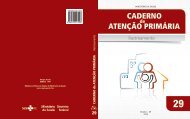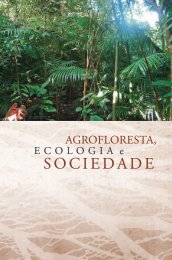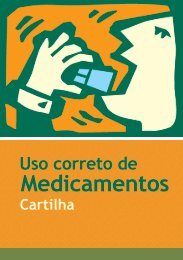Evolution of Oviductal Gestation in Amphibians
Evolution of Oviductal Gestation in Amphibians
Evolution of Oviductal Gestation in Amphibians
You also want an ePaper? Increase the reach of your titles
YUMPU automatically turns print PDFs into web optimized ePapers that Google loves.
410 M.H. WAKE<br />
A<br />
6<br />
Fig. 16. Fetal gills <strong>of</strong> viviparous caecilians. A A caeciliaid,<br />
Dermophis mexicanus (40 mm TL; note triramous, fimbriated<br />
gills). B: Typhlonectes natuns (36 mm TL; note enlarged, sac-<br />
like gills (from Wake, ’77b). Bars = 5 mm.<br />
6. Viviparity <strong>in</strong> amphibians <strong>in</strong>volves means <strong>of</strong> oral<br />
<strong>in</strong>gestion <strong>of</strong> the maternal nutrient material; placentae<br />
or pseudoplacentae are not developed <strong>in</strong> either the<br />
frog or the salamander, or <strong>in</strong> caecilians with the pos-<br />
sible exception <strong>of</strong> the typhlonectids. This is <strong>in</strong> marked<br />
contrast to the situation <strong>in</strong> many viviparous fishes,<br />
<strong>in</strong> which many embryonic epithelia serve as pseudo-<br />
placentae, and <strong>in</strong> viviparous reptiles <strong>in</strong> which the<br />
yolk sac and even the chorionic and allantoic extra-<br />
embryonic membranes function as placentae.<br />
7. Viviparous caecilians and the salamander have<br />
a fetal dentition <strong>in</strong>volved <strong>in</strong> <strong>in</strong>gest<strong>in</strong>g the nutrient<br />
secretion. However, the salamander uses “larval”<br />
teeth <strong>of</strong> the sort present <strong>in</strong> larvae <strong>of</strong> many species;<br />
the several viviparous species <strong>of</strong> caecilians have a<br />
fetal dentition that is unique <strong>in</strong> tooth crown shape<br />
and distribution among species and relative to the<br />
adult condition. The develop<strong>in</strong>g frog may make use<br />
<strong>of</strong> the fimbriae around its mouth as a “sponge” to<br />
gather the nutrient secretion for <strong>in</strong>gestion.<br />
The endocr<strong>in</strong>ology <strong>of</strong> viviparity <strong>in</strong> amphibians<br />
rema<strong>in</strong>s to be understood (Gallien, ’59; Amoroso et<br />
al., ’791, save for the elegant work <strong>of</strong> Xavier and<br />
her colleagues on the frog Nectophrynoides. In the<br />
same ve<strong>in</strong>, the <strong>in</strong>terplay <strong>of</strong> environmental factors<br />
with the <strong>in</strong>ternal ma<strong>in</strong>tenance <strong>of</strong> pregnancy must<br />
be better understood. So little is known <strong>of</strong> the de-<br />
tails <strong>of</strong> reproductive biology <strong>of</strong> these amphibians<br />
that research agendas might well be mounted. These<br />
animals could be “model systems” amenable to ex-<br />
perimental manipulation <strong>in</strong> order to <strong>in</strong>crease our<br />
understand<strong>in</strong>g <strong>of</strong> the evolution and ma<strong>in</strong>tenance<br />
<strong>of</strong> viviparity. However, most <strong>of</strong> the species discussed<br />
above are threatened by habitat destruction, and<br />
may be ext<strong>in</strong>ct before we can explore and under-<br />
stand their biology.<br />
ACKNOWLEDGMENTS<br />
I thank the organizers <strong>of</strong> the Symposium on Com-<br />
parative <strong>Gestation</strong> and Placentation <strong>in</strong> Vertebrates,<br />
July 1-6,1991, for <strong>in</strong>vit<strong>in</strong>g me to participate. I ap-<br />
preciate the stimulation that my graduate students<br />
who have worked on the evolution <strong>of</strong> viviparity<br />
(Lorrie Klosterman and Wendy Marlor) have given<br />
me. I wish to acknowledge the support <strong>of</strong> the Na-<br />
tional Science Foundation for my research on the<br />
evolutionary biology <strong>of</strong> amphibians.<br />
LITERATURE CITED<br />
Amoroso, E.C. (1952) Placentation. In: Marshall’s Physiology<br />
<strong>of</strong> Reproduction. AS. Parkes, ed. Longmans Green, New York,<br />
pp. 127-311.<br />
Amoroso, E.C. (1968) The evolution <strong>of</strong>viviparity. Roc. Roy. Soc.<br />
Med., 61:1188-1200.<br />
Amoroso, E.C., R.B. Heap, and M.B. Renfree (1979) Hormones<br />
and the evolution <strong>of</strong> viviparity. In: Hormones and <strong>Evolution</strong>.<br />
Vol. 2. E. J.W. Barr<strong>in</strong>gton, ed. Academic Press, New York, pp.<br />
925-929.<br />
Angel, F. (1943) Description d’un nouvel Amphibien anoure,<br />
ovovivipare, de la Haute-Gu<strong>in</strong>ee francoise. Bull. Mus. Paris,<br />
15:167-169.<br />
Angel, F., and M. Lamotte (1944) Un crapaud vivipare dAfrique<br />
occidentale Nectophrynoides occidentalis Angel. Ann. Sci. Nat.<br />
Zool., 6:63-89.<br />
Angel, F., and M. Lamotte (1948) Nouvelles observations sur






